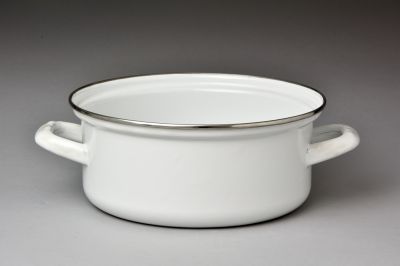
Pot - Cora - Kitchen Program for Prefabricated Houses
| Accession Nr.: | 88.378.1 |
|---|---|
| Artist/Maker: |
Ásztai, Csaba (1948 - ) / supervisor (chief designer) Soltész, György (1939 - 2006) / supervisor (chief designer) |
| Manufacturer: | Lampart Enamel Industry Works |
| Date of production: |
1975
|
| Place of production: | Bonyhád |
| Inscription: | jelzetlen |
|---|---|
| Materials: | steel sheet |
| Techniques: | enamelled |
| Dimensions: |
height: 9,5 cm
diameter: 20 cm
|
During the experiment of the Kitchen Program for Prefabricated Houses (1972–1975), there were people who saw the real and complex market-commercial opportunity that the program offered. Typically, representatives of these people, trusts and factories, went beyond the level of exhibition prototypes and came up with products. Lampart Enamel Industry Works already made a positive statement about the experiment at the Budapest International Fair in 1974, and after 1975, so after the end of the program, they used the designers of the Kitchen Program for Prefabricated Houses as a consultant. Led by Csaba Ásztai and György Soltész, pans, pots, kettles and kitchen utensils were born, which had several innovations: the pots and pans were designed to fit in the kitchen cabinet stacked on top of each other, their lids were designed with a gap for the removal of water vapor, and their solid metal or plastic handles could be easily cleaned. Their single-color or flower-patterned versions were based on the survey data that most housewives serve by placing the cookware directly on the dining table, so they should also have an aesthetic appearance. Perhaps this is why the products have been given female names in trade: Alice, Barbara, Cora, Diana.
Literature
- szerző: Vadas József: A magyar iparművészet története. A századfordulótól az ezredfordulóig. Corvina Kiadó, Budapest, 2014. - 189. kép (téves leltári számmal)
- Gáspár Zsuzsa: Design: Ipari formák a lakásban. Népművelési Propaganda Iroda, Budapest, 1977. - Nr. 63.









